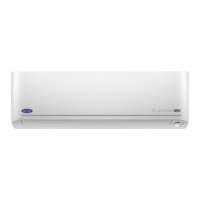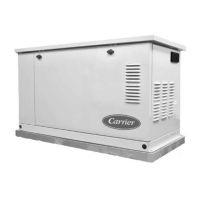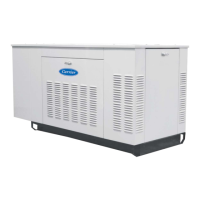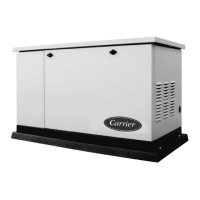T-361 2–4
2.3.4 Lube Oil Filter Arrangement
The engine lubricating oil filter is mounted in a horizontal arrangement and is shown in Figure 2.5.
Figure 2.5 Lube Oil
2.4 ENGINE SCREW THREADS
All threads on the engine are metric, except for the oil drain plug which is American Standard Pipe Thread (NPT).
2.5 ALTERNATING CURRENT GENERATOR
The generator bolts directly to the engine and supplies nominal 50/60Hz power depending on the load requirement.
2.6 BATTERY CHARGING SYSTEM
The solid state battery charger (see Figure 2.2) is located on top of the generator. The battery charger is powered
by the generator, and this input is protected by fuses located in the receptacle box. The battery charger produces a
tapered charge (40 amps maximum) and is designed not to overcharge the battery.
Observe proper polarity when installing the battery or connecting a battery charger. The nega-
tive battery terminal must be grounded. Reverse polarity may damage the charging system.
When charging the battery in unit, isolate the battery by disconnecting the negative battery ter-
minal first, then the positive. Once the battery has been charged, connect the positive battery
terminal first, then the negative.
2.7 VOLTAGE CONTROLLER
Voltage Controller maintains ISO voltage via two-speed and dual winding control. It regulates voltage in order to
keep the generator output within ISO limits:
• 50Hz: 1500 RPM, 360-460 VAC
• 60Hz: 1800 RPM, 400-500 VAC
2.8 OPERATING CONTROLS & INSTRUMENTS
2.8.1 Introduction
Components required for monitoring and controlling the unit are located in the control box, on the control panel
(seeFigure 2.1) and on the receptacle box (see Figure 2.1).
2.8.2 Control Panel and Related Components
1. Gauges and Senders
a. Oil Pressure Gauge (see Figure 2.6 or Figure 2.7)
The purpose of this gauge is to observe normal operating engine oil pressure. Normal oil pressure is 35
to 60 psig (3.3 to 5.2 kg/cm
2
).
Oil Pan
Oil Pressure Switch
Oil Filter (Primary)
Oil Pressure Sender

